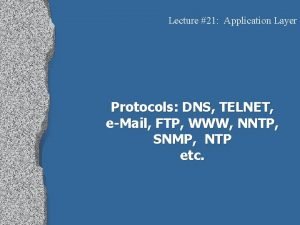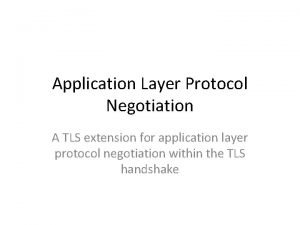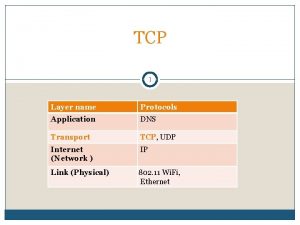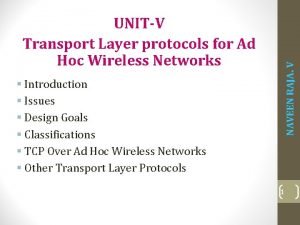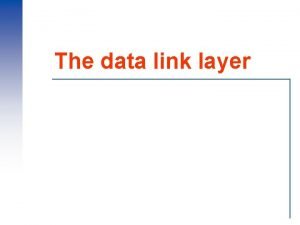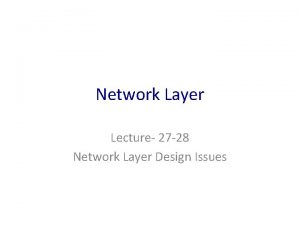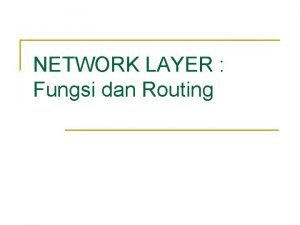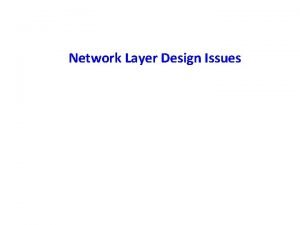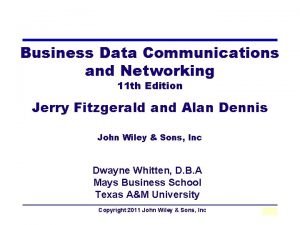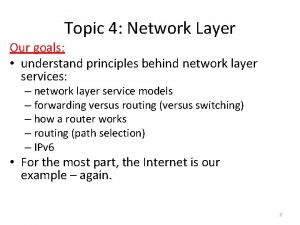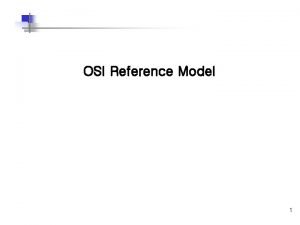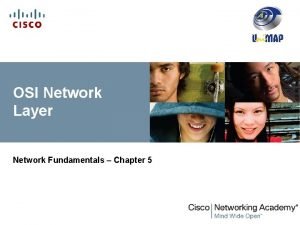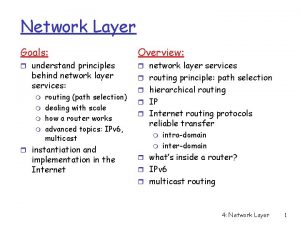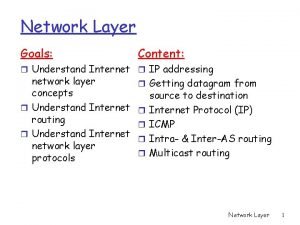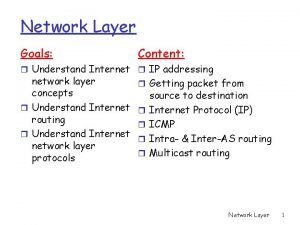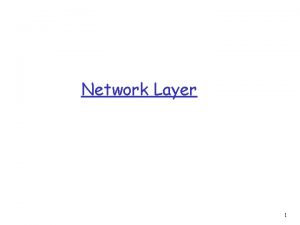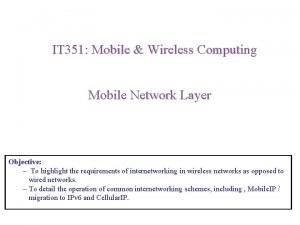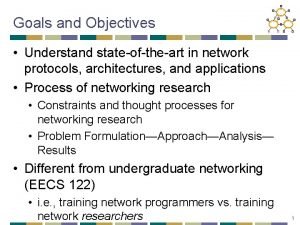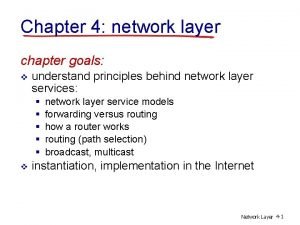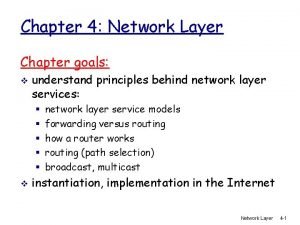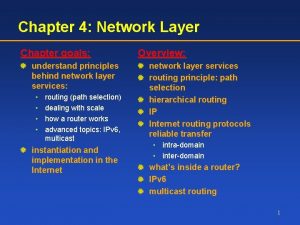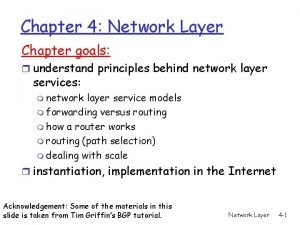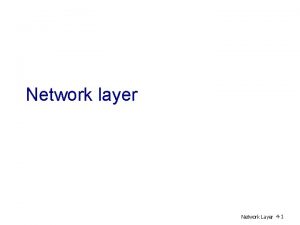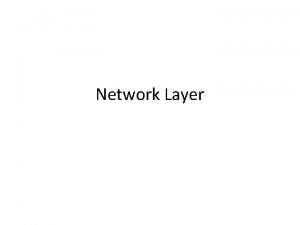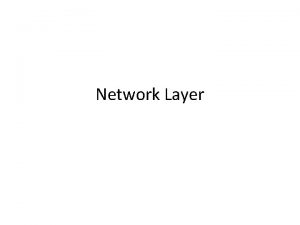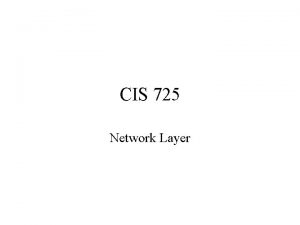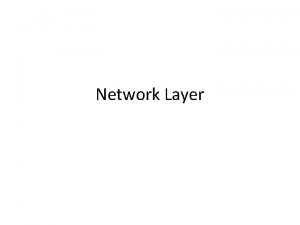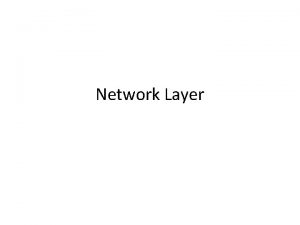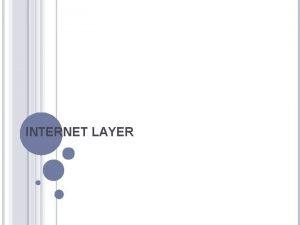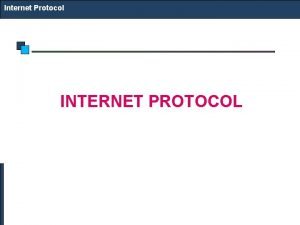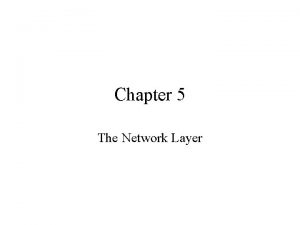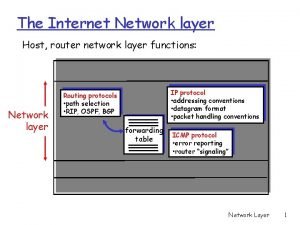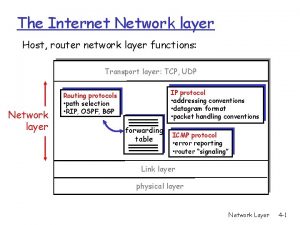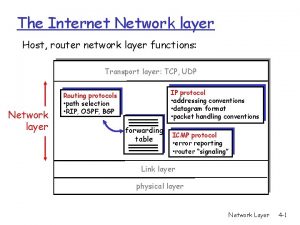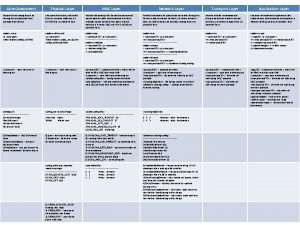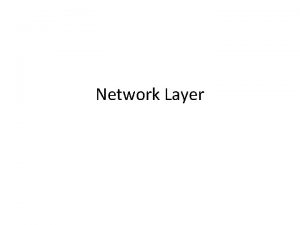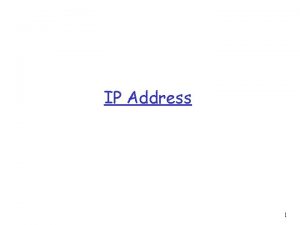The Network Layer Internet Protocol IP Internet Protocol






































- Slides: 38

The Network Layer Internet Protocol IP

Internet Protocol • IP (Internet Protocol) is a Network Layer Protocol.

What is an IP address Ø A way to identify machines on a network Ø A unique identifier

IP usage Ø Used to connect to another computer Ø Allows transfers of files and e-mail

IP structure Ø IP addresses consist of four sections Ø Each section is 8 bits long Ø Each section can range from 0 to 255 Ø Written, for example, 128. 35. 0. 72

IP structure Ø These four sections represent the machine itself and the network it is on Ø The network portion is assigned. Ø The host section is determined by the network administrator

IP structure Ø 5 Classes of IP address A B C D and E Ø Class A reserved for governments Ø Class B reserved for medium companies Ø Class C reserved for small companies

IP structure Ø Class D are reserved for multicasting Ø Class E are reserved for future use

IPv 4 Addresses The identifier used in the IP layer of the TCP/IP protocol suite to identify each device connected to the Internet is called the Internet address or IP address. An IPv 4 address is a 32 -bit address that uniquely and universally defines the connection of a host or a router to the Internet; an IP address is the address of the interface.

Topics Discussed in the Section üNotation üRange of Addresses üOperations

Note • An IPv 4 address is 32 bits long. • The IPv 4 addresses are unique and universal. • The address space of IPv 4 is 232.

Dotted-decimal notation

Example • Change the following IPv 4 addresses from binary notation to dotted -decimal notation. • a. 10000001011 11101111 • b. 110000011 00011011 1111 • c. 11100111 11011011 10001011 01101111 • d. 111110011011 11111011 00001111 • Solution • We replace each group of 8 bits with its equivalent decimal number and add dots for separation: • a. 129. 11. 239 • b. 193. 131. 27. 255 • c. 231. 219. 139. 111 • d. 249. 155. 251. 15

Example • • • Change the following IPv 4 addresses from dotted-decimal notation to binary notation. a. 111. 56. 45. 78 b. 221. 34. 7. 82 c. 241. 8. 56. 12 d. 75. 45. 34. 78 Solution We replace each decimal number with its binary equivalent: a. 01101111 00111000 00101101 01001110 b. 1101 0010 00000111 01010010 c. 11110001 00001000 00111000 00001100 d. 0100101101 0010 01001110

Example • • Find the error, if any, in the following IPv 4 addresses: a. 111. 56. 045. 78 b. 221. 34. 7. 8. 20 c. 75. 45. 301. 14 d. 11100010. 23. 14. 67 Solution a. There should be no leading zeroes in dotted-decimal notation (045). • b. We may not have more than 4 bytes in an IPv 4 address. • c. Each byte should be less than or equal to 255. • d. A mixture of binary notation and dotted-decimal notation.

Example • Change the following IPv 4 addresses from binary notation to hexadecimal notation. • a. 10000001011 11101111 • b. 110000011 00011011 1111 • Solution • We replace each group of 4 bits with its hexadecimal equivalent. Note that 0 X (or 0 x) is added at the beginning or the subscript 16 at the end. • a. 0 X 810 B 0 BEF or 810 B 0 BEF 16 • b. 0 XC 1831 BFF or C 1831 BFF 16

Example • The first address in a range of addresses is 14. 11. 45. 96. If the number of addresses in the range is 32, what is the last address? • Solution • We convert the number of addresses minus 1 to base 256, which is 0. 0. 0. 31. We then add it to the first address to get the last address. Addition is in base 256.

CLASSFUL ADDRESSING • IP addresses, when started a few decades ago, used the concept of classes. This architecture is called classful addressing. In the mid-1990 s, a new architecture, called classless addressing, was introduced that supersedes the original architecture. In this section, we introduce classful addressing because it paves the way for understanding classless addressing and justifies the rationale for moving to the new architecture. Classless addressing is discussed in the next section.

the class of address

Example • • • Find the class of each address: a. 00000001011 11101111 b. 110000011 00011011 1111 c. 10100111 11011011 10001011 01101111 d. 11110011011 11111011 00001111 • • • Solution a. The first bit is 0. This is a class A address. b. The first 2 bits are 1; the third bit is 0. This is a class C address. c. The first bit is 1; the second bit is 0. This is a class B address. d. The first 4 bits are 1 s. This is a class E address.

Example • Find the class of each address: • a. 227. 12. 14. 87 • b. 193. 14. 56. 22 • c. 14. 23. 120. 8 • d. 252. 5. 111 • Solution • a. The first byte is 227 (between 224 and 239); the class is D. • b. The first byte is 193 (between 192 and 223); the class is C. • c. The first byte is 14 (between 0 and 127); the class is A. • d. The first byte is 252 (between 240 and 255); the class is E.

Netid and Hostid • In classful addressing, an IP address in classes A, B, and C is divided into netid and hostid. • These parts are of varying lengths, depending on the class of the address. • shows the netid and hostid bytes. Note that classes D and E are not divided into netid • In class A, 1 byte defines the netid and 3 bytes define the hostid. In class B, 2 bytes define the netid and 2 bytes define the hostid. In class C, 3 bytes define the netid and 1 byte defines the hostid


Classes and Blocks • One problem with classful addressing is that each class is divided into a fixed number of blocks with each block having a fixed size. Let us look at each class.

Class A • Since only 1 byte in class A defines the netid and the leftmost bit should be 0, the next 7 bits can be changed to find the number of blocks in this class. Therefore, class A is divided into 27= 128 blocks that can be assigned to 128 organizations (the number is less because some blocks were reserved as special blocks). However, each block in this class contains 16, 777, 216 addresses

Blocks in Class A

Class B • Since 2 bytes in class B define the class and the two leftmost bit should be 10 (fixed), • the next 14 bits can be changed to find the number of blocks in this class. Therefore, class B is divided into 214= 16, 384 blocks that can be assigned to 16, 384 organizations • (the number is less because some blocks were reserved as special blocks). However, each block in this class contains 65, 536 addresses. Not so many organizations can use • so many addresses. Many addresses are wasted in this class.

Blocks in Class B

Class C • Since 3 bytes in class C define the class and the three leftmost bits should be 110 (fixed), the next 21 bits can be changed to find the number of blocks in this class. Therefore, class C is divided into 221 =2, 097, 152 blocks, in which each block contains 256 addresses, that can be assigned to 2, 097, 152 organizations (the number is less because some blocks were • reserved as special blocks). Each block contains 256 addresses.

Blocks in Class C

Two-level addressing in classful addressing

Information extraction in classful addressing

Network Mask • The routers in the Internet normally use an algorithm to extract the network address from the destination address of a packet. To do this, we • need a network mask. A network mask or a default mask in classful addressing is a 32 -bit number with n leftmost bits all set to 1 s and (32 − n) rightmost bits all set to 0 s. Since n is different for each class in classful addressing, we have three default masks in classful addressing

Network mask

Finding a network address using the default mask

Example • A router receives a packet with the destination address 201. 24. 67. 32. Show the router finds the network address of the packet.

Reserved addresses Ø Addresses beginning 127 are reserved for loopback and internal testing Ø xxx. 0. 0. 0 reserved for network address Ø xxx. 255 reserved for broadcast

Examples of Reserved addresses • • • 0. 0 127. 0. 0. 0 128. 0. 0. 0 191. 255. 0. 0 192. 0. 0. 0 223. 255. 0
 Fig 19
Fig 19 Phases of deglutition
Phases of deglutition Secure socket layer and transport layer security
Secure socket layer and transport layer security Presentation layer functions
Presentation layer functions Secure socket layer and transport layer security
Secure socket layer and transport layer security Secure socket layer and transport layer security
Secure socket layer and transport layer security Secure socket layer and transport layer security
Secure socket layer and transport layer security Layer 2 e layer 3
Layer 2 e layer 3 Layer-by-layer assembly
Layer-by-layer assembly Layer 2 vs layer 3 bitstream
Layer 2 vs layer 3 bitstream Dns application layer protocol
Dns application layer protocol Application layer protocol negotiation
Application layer protocol negotiation A link layer protocol for quantum networks
A link layer protocol for quantum networks Dns transport layer protocol
Dns transport layer protocol Design goals of transport layer protocol
Design goals of transport layer protocol Link
Link Higher layer ssl protocol
Higher layer ssl protocol Unrestricted simplex protocol
Unrestricted simplex protocol Atm aal
Atm aal Network layer design
Network layer design The network layer is concerned with of data.
The network layer is concerned with of data. Fungsi network layer
Fungsi network layer Implementation of connectionless service
Implementation of connectionless service Introduction to network layer
Introduction to network layer 5 layer network model
5 layer network model Two layer network
Two layer network Goals of network layer
Goals of network layer Osi leyer
Osi leyer Goals of network layer
Goals of network layer Goals of network layer
Goals of network layer Goals of network layer
Goals of network layer Goals of network layer
Goals of network layer Goals of network layer
Goals of network layer Mobile network layer
Mobile network layer Networking goals and objectives
Networking goals and objectives Goals of network layer
Goals of network layer Goals of network layer
Goals of network layer Goals of network layer
Goals of network layer Goals of network layer
Goals of network layer










